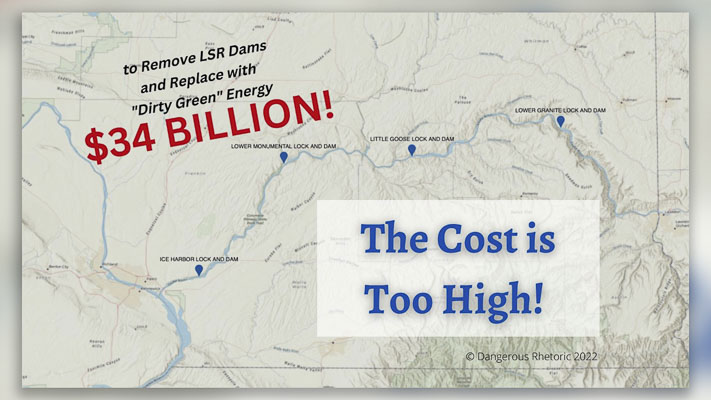
Nancy Churchill believes taxpayer money should not be wasted on one stretch of river, only to leave Washington’s electricity less reliable
Nancy Churchill
Dangerous Rhetoric
At the beginning of November, the Washington Policy Center and Center of the American Experiment published a joint analysis titled “The High Cost of Removing the Lower Snake River Dams”. This report details how Gov. Inslee and Sen. Patty Murray’s proposal to remove the LSR dams and replace them with wind, solar, and battery storage would likely cost Washington State taxpayers around $34.3 billion. This would also mean that Washington electricity customers would pay an additional $330 per year, on average, through 2050.

Inslee and Murray recommend the removal of these dams because they believe that salmon and other species in Washington state will not recover while the four dams are in place. The four Lower Snake River dams are Ice Harbor, Lower Monumental, Little Goose, and Lower Granite. Removing these dams would transform Washington from a state with some of the lowest electricity prices in the country to a state with much higher costs.
Inslee is pushing for all electric vehicles in Washington State by 2030. All these new electric vehicles will increase demand for electricity. Democrats have also passed laws to require home heating to become all electric. Removing the dams affordable, carbon-free electricity generation capacity while pushing consumers into greater electricity use just doesn’t make much sense.
The report estimates “the total cost of replacing the generation of the LSR dams with 100 percent wind, solar and battery storage would be $34.3 billion based on 2021 LSR dam generation and real-world wind and solar capacity factors for the region.” Electricity rates would increase about 25%. Relying on weather dependent sources like wind and solar will also decrease the reliability of the grid, which would increase the likelihood of brown-outs or black-outs during very cold or very hot weather.
The dams provide other benefits, including transportation for goods, irrigation, and tourism, which must be addressed in any proposal advocating their removal.
Focusing on agriculture, most of Eastern Washington’s agriculture industry would be difficult to maintain without the irrigation provided by the dams and reservoirs.
According to the Washington Department of Commerce, “Washington’s 15 million acres of farmland produce 300 different crops, ranking second in the nation.” Commerce continues, “Combined with the state’s low-cost energy —some of the lowest in the nation—and superior crop and harvest yields, Washington is a natural choice for agricultural operations, food production, storage and manufacturing.” How could we possibly continue to be the 2nd most productive state in the nation without the dams? Is this even a responsible choice given the looming food shortages elsewhere in the world?
Policy recommendations
This report offers three important common-sense policy recommendations which would keep Washington’s energy affordable while improving outcomes for salmon recovery. If adopted, these policies could save Washington electricity customers and taxpayers billions of dollars in the coming decades.
First, Washington should keep our renewable and green hydropower dams. These represent an important taxpayer investment that should not just be thrown away in favor of dirty-green energy production that is unreliable, expensive, and environmentally toxic.
Next, allow for the construction of new natural gas plants in Washington. It is currently not legal. Dam opponents admit dam removal will increase reliance on natural gas, so a first step would be to build some new electrical capacity. We should also allow for the construction of nuclear power plants, which have great potential with the development of new plant technology.
Finally, Washington should dedicate funding for salmon recovery to projects across the state. Rather than waste huge amounts of taxpayer money on one stretch of river, only to leave Washington’s electricity less reliable, salmon-recovery advocates should push for funding to be used where it can be most effective across the Northwest. Many successful projects have helped to increase runs and have brought new life back many of our inland rivers. Let’s continue and redouble these practical and effective salmon recovery projects and focus on doing what works rather than on destroying the amazing, productive, powerful and green Snake River Dams.
Nancy Churchill is the state committeewoman for the Ferry County Republican Party. She may be reached at DangerousRhetoric@pm.me. The opinions expressed in Dangerous Rhetoric are her own.
Also read:
- Letter: ‘We’re going to give them some money and a plane ticket, and then we’re going to work with them’Camas resident Anna Miller supports a new structured self-deportation policy, calling it a balanced approach to immigration and economic needs.
- Opinion: What the 2025 legislature tells us about why Washington’s government keeps failingTodd Myers of the Washington Policy Center argues that Washington’s government fails because it resists humility, experimentation, and accountability in its policymaking.
- Letter: Vancouver needs broader leadership than just a teacher’s lensVancouver resident Peter Bracchi urges Mayor Anne McEnerny-Ogle not to seek another term, calling for more diverse and inclusive leadership rooted in broader experiences.
- Opinion: Legislative session ‘was full of ups and downs and many learning experiences’Rep. John Ley reflects on the 2025 legislative session, highlighting local funding victories and warning of major tax increases passed by the majority.
- Opinion: Washington state Legislature 2025: That’s a wrapElizabeth New (Hovde) of the Washington Policy Center breaks down the highlights and lowlights of Washington’s 2025 legislative session, warning of rising taxes and new mandates.











Leave the dams alone, and manage the “environment” as it currently exists. Here in Washington, the wind doesn’t always blow and the sun doesn’t always shine (especially in winter.) Current hydro-electric power is far more predictable and reliable. Inslee and Muray are politicians and lack in basic common sense….